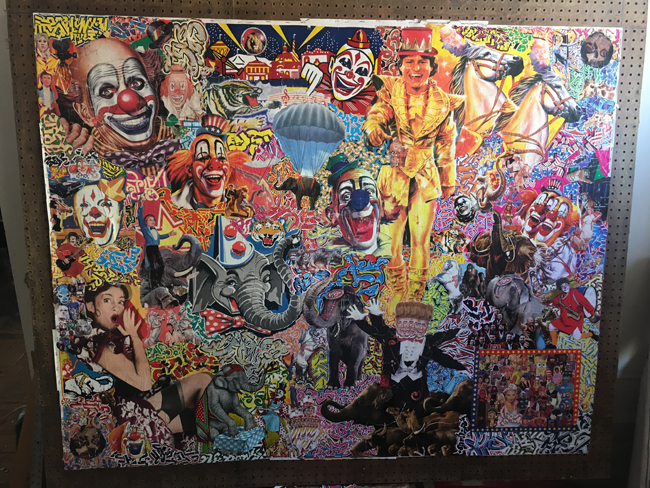
NEW YORK — Last month the world lost an utterly unique and original American artist. Born in the Bronx in 1968, Michael Anderson was essentially a self-taught artist, internationally known for his large-scale collage which he made chiefly from street posters, gathered from cities world-wide. Anderson was a big man with a big heart – his canvas was large, and his vision was large, even when he was working on a small surface. I was always struck by how extraordinarily well read and knowledgeable he was about so many and varied things. There scarce seemed to be any major author with which he was not familiar. Mythology, history, philosophy, and religion endlessly intrigued and fascinated him. It is all there in his art, which was not about himself nearly as much as it was about the world. The encyclopedic range with which he made associations, novel connections and surprising cross references – it is all there on those mighty canvases which he built up, methodically, layer by layer.
Anderson enjoyed a long and prolific career as a collage artist, much loved by critics and collectors the world over. His last solo show was at New York’s Arts and Leisure gallery earlier this year. I wrote about that show at the time. It included a number of fairly recent works, among them the epic title piece, Armageddon Yacht. However, having spent many hours at his live-in studio at 106th Street, I also knew that Anderson had scores of soaring pieces which the public had never seen. Among these was the breathtakingly immense work which he referred to as his masterpiece, the 15’ by 6’ Attack of the Fifty Foot Three Graces, seamlessly constructed out of three panels. Anderson had a gift for titles, which often displayed his mischievous wit, and wry sense of humor. This monumental work with its virtually endless visual references is a testimony to how deeply Anderson drank at the well of Western art, how imbued he was with its history, from the ancients to the baroque, to the modern masters that he so admired. As I write these words the fate of this and many other extraordinarily important pieces remains uncertain.
Another extraordinary piece, Circus Maximus (2019) is one that I so deeply admired from the moment I saw it complete, for its vitality, its de-centered yet exquisitely balanced structure, its thematic unity, and vibrant palette, its countless intertwining stories – I so wanted my kids to grow up with this lively and inexhaustible work that Anderson kindly let me have it and pay it off gradually. He told me he had been collecting the materials that went into it for seven years, which could hardly be doubted. Michael waited until it had become something of the past and then he created this epic tribute to the circus world with all its zaniness, its indefatigable physicality, its costumes and clowns with their joviality yet frightening undercurrents, the animals, elephants, and lions, and so much more. The circus always struck me as a theme for which Anderson’s art was destined, perfectly suited to his unstoppable talent for deconstruction and recreation – here was a subject the content of which he could explore, take apart and endlessly reconfigure in his inimitable style. Anderson could in life play the clown, laughing or crying, for he was not afraid to show his tears – but he was most truly, I believe, the tightrope walker: always living on the edge but with supreme skill, and poise, and his own style of grace.
Dark, stormy, and violent as his work could be, Anderson ultimately embraced the world with all its incurable messiness and inscrutable mystery. His art was notably generous when it came to content, but as an artist he was first and foremost concerned with form, composition, structure – rhythm, point and counterpoint, harmony, and dissonance, these are the things which propelled him. Michael dwelt long and lovingly on the ‘interstices’, as he would call them, the use of negative space within a painting or picture. Good art for him was and had to be exciting, jaw dropping, bold. He drew inspiration from everywhere, he drank up the world and transformed it within his boundless imagination. He took the fragments, the detritus of a visually over-saturated culture and produced out of such disparate materials works possessed of undeniable depth, originality, and power.
Anderson was also a great collector. He must have amassed the world’s single largest collection of street stickers, which he told me he intended to bequeath to the Smithsonian. With those tens of thousands of graffiti stickers, he created a mural for the lobby of New York City’s Ace Hotel in 2009. He also collected street flyers with which he created the Abject Street Wallpaper installation in 2012. When it came to art Michael simply could not miss – his vision was unerring. Everything he did was informed by an apparently innate and sophisticated sense of composition, which could produce forms simple or complex depending on what was called for, but always shaped by an aesthetic intuition which brooked nothing second rate, or anything less than flawless. The consummate perfectionist, he would fine tune large works with hundreds, or rather thousands of minute additions which put the final polish on a collage.
Anderson was a great talker, an engaging conversationalist, he could be loud and boisterous, he could also be extremely kind and tender. A gentle soul inside an immense frame, all who truly knew him will miss the man as much as the artist. The man is gone. The artist lives on.
*
*Sam Ben-Meir, Ph.D, is a professor of philosophy and world religions at Mercy College in New York City.

Beautiful description that really captures the essence of Michael. I was introduced to Michael by my wife Jaimie Walker, also an artist in the DUMBO Brooklyn scene from the early 2000s. I bought my first artwork from him shorty after. My first original artwork. Going on to add three more pieces over the years. I’ll miss the random calls just to catch up and hear about his adventures and new pieces that ‘i need to see’ and how he wanted to ‘touch up’ a few of our pieces. The last call a few weeks prior to his passing, Michael sounded reflective and concerned about our isolation during the pandemic. We promised to come to his studio in Harlem for dinner and drinks when things ‘got back to normal’ I’m thankful we spoke that night but will miss our future dinner plan. I’m sure it would’ve been as memorable as most all Michael Anderson encounters. He will live on through his work.
An extraordinary artist who, though his life was cut tragically short, would yet be satisfied if his work lived on to inspire generations of artists and collectors. Perhaps owners of his pieces can come together to create a catalog of his art that can then be used to produce prints, exposing the larger public to his timeless works through the opportunity to explore, study, and purchase small and full size posters. As one such owner, I will do my part so that Michael lives on.